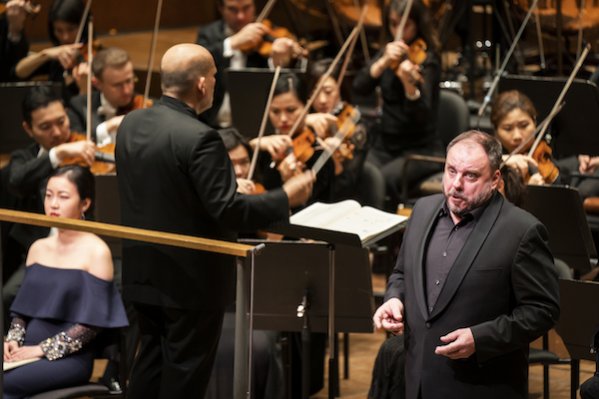Philharmonic, Concert Chorale provide consolation and elevation with Brahms’ “German Requiem”

Jaap van Zweden conducted the New York Philharmonic in Brahms’ “German Requiem” with soloists Matthias Goerne and Ying Fang Thursday night at David Geffen Hall. Photo: Chris Lee
Whether or not Johannes Brahms was a mournful person by nature — the “first class undertaker” dinged by critic George Bernard Shaw — it’s worth noting that “A German Requiem” may be the least morbid of classical music’s great symphonic masses for the departed. One of its most appealing qualities, in fact, is that it feels like it’s more for the living than the dead.
From its titanic scale, a listener could infer that only gods and emperors merit a lamentation this epic. But “A German Requiem” wasn’t a royal or ecclesiastical commission; Brahms began work on it, on his own initiative, in his late 20s. He completed it after his mother died. So his motives were more personal and, to judge from the Bible verses he chose, his concern rested more with the well being of those left behind.
The New York Philharmonic’s performance of Brahms’ work Thursday evening at David Geffen Hall did not stint on sadness or grandeur. But in this first of three, there was also care and sweetness — a lighter touch for the softening of grief alongside the heavier strokes that etch it in memory. The orchestra, the two soloists and, especially, the Concert Chorale of New York presented the music more as a consolation than an exalted tribute to the deceased (Mozart) or a dark contemplation of death itself (Ligeti).
Without diminishing the contributions of baritone Matthias Goerne and soprano Ying Fang, the 80-member Chorale was the voice, centerpiece and highlight of this concert. Their singing — in German, with English translations projected overhead — communicated the work’s emotional weight, and imbued it with a clear and simple humanity even at the large orchestral scale of Brahms’ writing.
The first of the requiem’s seven movements began with a heart-tugging downdraft of strings, and music director Jaap van Zweden setting a tone of watchful solemnity. Stationed behind and slightly above the orchestra, the voices of the Chorale seemed to just materialize, as if transmuted, with the opening lines from Matthew: “Blessed are they that mourn: for they shall be comforted.”
The choir’s upper- and lower-register exchanges were carefully balanced, and gentle yet powerful in their expressions of both bereavement and solace. As the movement alternated between orchestral and vocal passages, and wherever the forces overlapped, van Zweden produced the right amount of blending or separation each moment required. Closing with an excerpt from Psalms — “They that sow in tears shall reap in joy” — this was as perfectly rendered an opening movement as one will hear in any symphonic work.
There was barely a hitch the rest of the way: a tiny lapse in intonation from the brass section in the second and last movements; a bit of starch in Fang’s voice at the very top of the scale in her seraphic turn in the fifth movement; some collective laboring to get to the peak of a dramatic crescendo in the second movement.
Everywhere else — from the delicacy of the winds in the fourth movement to the massive syncopations of two coda-like fugues in the third and sixth movements — van Zweden and the Philharmonic situated themselves precisely within Brahms’ complex and ambitious embroidery of instruments and voices
You could argue whether Goerne’s singing in the third and sixth movements was sometimes too actorly — he has sung this requiem with the Philharmonic before. But there was no denying the mix of awe and anguish in his voice as he pleaded to be freer of earthly attachments, or the Wagnerian power of his invocation of “the last trumpet” signaling the Resurrection.
But again, the music’s energy seemed to flow primarily through the choir. It was there, technically, in their flawless diction; and present poetically in the hushed beauty of Isaiah’s promise to treat the grieving “as one whom his mother comforts,” or the regal evocation of “glory, honor and power” — from Revelations — in the mighty fugue concluding the sixth movement.
The requiem also concludes with a passage from Revelations, “Blessed are the dead.” The integration of male and female choral voices in that finale Thursday seemed to produce a timbre without gender — a voice of the afterlife, perhaps, that Brahms turned to in the closing section.
The program will be repeated 8 p.m. Saturday. nyphil.org; 212-875-5656